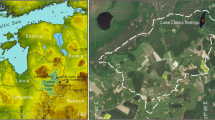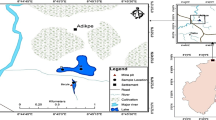Abstract
Distributions of alkylated chromans and C20 isoprenoid thiophenes were investigated in four organic-matter- and sulfur-rich black shales of Miocene age deposited in the ancient crater lake of the Nördlinger Ries (southern Germany), a meteorite impact crater. Paleosalinity parameters based on these compound classes generally confirm sedimentological evidence of increased salinity over certain periods of the lake's history, but the data from both groups of compounds are not consistent. Diagenetically related molecular constituents were therefore studied to estimate the sensitivity of these parameters. The influence of thiolanes on the isoprenoid thiophene parameter was found to be low, whereas too little is known at present about the origin and diagenetic fate of alkylated chromans to conclude definitely that an alkylated chroman paleosalinity parameter can reliably be applied to a wide range of depositional settings.
Similar content being viewed by others
References
Barbe A., Grimalt J.O., Pueyo J.J. and Albaigés (1990) Characterization of model evaporitic environments through the study of lipid components. Org. Geochem. 16, 815-828.
Barakat. A.O. and Rullkötter J.R. (1995) The distribution of free organic sulfur compounds in sediments from the Nördlinger Ries (southern Germany). In (eds. Vairavamurthy M. and Schoonen M.A.A.), Geochemical Transformations of Sedimentary Sulfur ACS Symp. Ser. 612, pp. 311-331. American Chemical Society, Washington.
Benali S., Schreiber B.C., Helman M.C. and Philp R.P. (1995) Characterization of organic matter from a restricted evaporitive sedimentary environment: Late Miocene of Lorca Basin, Southeastern Spain. Am. Assoc. Petr. Geol. Bull. 79, 816-830.
Benalioulhaj S., Schreiber B.C., Philp R.P. and Landais P. (1994) Assessment of biomarkers characteristic of hypersalinity using artificial maturation on sediments from diverse evaporitic environments. In (ed. K. Øygard), Organic Geochemistry 532-535. Falch Hurtigtrykk, Oslo.
Benalioulhaj S., Schreiber B.C. and Philp R.P. (1994) Relationship of organic geochemistry to sedimentation under highly varyiable environments, Lorca Basin, Spain: Preliminary results. In Sedimentology and Geochemistry of Modern and Ancient Saline Lakes. SEPM Special Publication 50, 315-324.
Brassell S.C. and Eglinton G. (1986) Molecular geochemical indicators in sediments. In (ed. Sohn M.L.), Organic Marine Geochemistry ACS Symposium Series 305, pp. 10-32. American Chemical Society, Washington.
Brassell S.C., Eglinton G. and Madwell J.R. (1983) The geochemistry of terpenoids and steroids. Biochem. Soc. Trans. 11, 575-586.
Brassell S.C., Eglinton G. and Fu Jiamo (1986) Biological marker compounds as indicators of the depositional history of the Maoming oil shale. In (eds. Leythauser D. and Rullkötter J.), Advances in Organic Geochemistry 1985 Org. Geochem. 10, 927-941. Pergamon Press, Oxford.
Brassell S.C., Eglinton G. and Howell V.J. (1987) Paleoenvironmental assessment of marine organicrich sediments using molecular organic geochemistry. In (eds Brooks J. and Fleet A.J.), Marine Petroleum Source Rocks Geol. Soc. Spec. Publ. No. 26, pp. 79-98. Blackwell, Oxford.
Brassell S.C., Sheng Guoying, Fu Jiamo and Eglinton G. (1988) Biological markers in lacustrine Chinese oil shales. In (eds. Kelts K., Fleet A.J. and Talbot M.), Lacustrine Petroleum Source Rocks Geol. Soc. Spec. Publ. No 26, pp. 99-117. Blackwell, Oxford.
Comet P.A. and Eglinton G. (1987) The use of lipids as facies indicators. In (eds. Brooks J. and Fleet A.J.), Marine Petroleum Source Rocks Geol. Soc. Spec. Publ. No. 26, pp. 99-117. Blackwell, Oxford.
Elliot W.H. and Waller G.R. (1972) Vitamins and co-factors. In (eds. Waller G.R.), Biochemical Applications of Mass Spectrometry Wiley, New York, pp. 499-536.
Goossens H., de Leeuw J.W., Schenck P.A. and Brassell S.C. (1984) Tocopherols as likely precursors of pristane in ancient sediments and crude oils. Nature, London 312, 440-442.
Grimalt J.O., de Wit R., Teixidor P. and Albaigés J. (1992) Lipid geochemistry of Phormidium and Microcoleus mats. Org. Geochem. 19, 509-530.
ten Haven H.L., de Leeuw J.W. and Schenck P.A. (1985) Organic geochemical studies of a Messinian evaporitic basin, northern Apennines (Italy) I: Hydrocarbon biological markers for a hypersaline environment. Geochim. Cosmochim. Acta 49, 2181-2191.
ten Haven H.L., de Leeuw J.W., Sinninghe Damsté J.S., Schenck P.A., Palmer S.E. and Zumberge J.E. (1988) Application of biological markers in the recognition of palaeohypersaline environments. In (eds. Kelts K., Fleet A.J. and Talbot M.), Lacustrine Petroleum Source Rocks Geol. Soc. Spec. Publ. No 26, Blackwell, Oxford, pp. 123-140.
ten Haven H.L., Rullkötter J., Sinninghe Damsté J.S. and de Leeuw J.W. (1990) Distribution of organic sulfur compounds in Mesozoic and Cenozoic sediments from the Atlantic and pacific Oceans and the Gulf of Mexico. In (eds. Orr W.L. and White C.M.), Geochemistry of Sulfur in Fossil Fuels ACS Symp. Ser. 249, American Chemical Society, Washington, pp. 613-632.
Janiszowska W. and Pennock J.F. (1976) The biochemistry of vitamin E in plants. In (eds. Munson P.L., Diczfalusky E., Glover J. and Alson R.E.), Vitamins and Hormones Academic Press, London, 34, 77-105.
Jankowski B. (1981) Die Geschichte der Sedimentation im Nördlinger Ries und Randecker Maar. Bochumer Geol. und Geotechn. Arb. Vol. 6. Ruhr-Universität Bochum.
Kohnen M.E.L., Schouten S., Sinninghe Damsté J.S., de Leeuw J.W., Merrit D.A. and Hayes J.M. (1992) Recognition of palaeobiochemicals by a combined molecular sulphur and isotope geochemical approach. Science 256, 358-362.
de Leeuw J.W. and Sinninghe Damsté J.S. (1990) Organic sulphur compounds and other biomarkers as indicators of palaeosalinity: A critical evaluation. In (eds. Orr W.L. and White C.M.), Geochemistry of Sulfur in Fossil Fuels ACS Symp. Ser. 249, pp. 417-443. American Chemical Society, Washington.
Li Maowen, Larter S.R., Taylor P., Jones D.M., Bowler B., and Bjorøy M. (1995) Biomarkers or not biomarkers? A new hypothesis for the origin of pristane involving derivation from methyltrimethyltridecylchromans (MTTCs) formed during diagenesis from chlorophyll and alkylphenols. Org. Geochem. 23, 159-167.
Moldowan J.M., Seifert W.K. and Gallegos E.J. (1985) Relationship between petroleum composition and depositional environment of petroleum source rocks. Am. Assoc. Pet. Geol. Bull. 69, 1255-1268.
Murray A.P., Summons R.E., Borcham C.J. and Dowling L.M. (1994) Biomarker and n-alkane isotope profiles for Tertiary oils: relationship to source rock depositional setting. Org. Geochem. 22, 521-542.
Peters K.E. and Moldowan J.M. (1991) Effects of source, thermal maturity and biodegradation on the distribution and isomerization of homohopanes in petroleum. Org. Geochem. 17, 47-61.
Peters K.E. and Moldowan J.M. (1993) The Biomarker Guide. Prentice Hall, Englewood Cliffs, NJ.
Philp R.P. and Lewis C.A. (1987) Organic geochemistry of biomarkers. Rev. Earth Planet. Sci. 15, 363-395.
Radke M., Willsch H. and Welte D.H. (1980) Preparative hydrocarbon group type determination by automated medium pressure liquid chromatography. Anal. Chem. 52, 406-411.
Rullkötter J. and Marzi R. (1988) Natural and artificial maturation of biological markers in a Toarcian shale from northern Germany. In (eds. Mattavelli L. and Novelli L.), Advances in Organic Geochemistry 1977. Org. Geochem. 13, 639-645, Pergamon Press, Oxford.
Rullkötter J., Littke R. and Schaefer R.G. (1990) Characterization of organic matter in sulfur-rich lacustrine sediments of Miocene age (Nördlinger Ries, southern Germany). In (eds. Orr W.L. and White C.M.), Geochemistry of Sulfur in Fossil Fuels ACS Symp. Ser. 249, pp. 149-169. American Chemical Society, Washington.
Schoell M., Hwang R.J., Carlson R.M.K. and Welton J.E. (1994) Carbon isotopic composition of individual biomarkers in gilsonites (Utah). Org. Geochem. 21, 673-683.
Sinninghe Damsté J.S., Kock-van Dalen A.C., de Leeuw J.W., Schenck P.A., Sheng Guoying and Brassell S.C. (1987a) The identification of mono-, di-and trimethyl 2-methyl-2-(4,8,12,-trimethyltridecyl)chromans and their occurrence in the geosphere. Geochim. Cosmochim. Acta 51, 2393-2400.
Sinninghe Damsté J.S., Kock-van Dalen A.C., de Leeuw J.W., Schenck P.A., (1987b) The identification of 2,3-dimethyl-5-(2,6,10-trimethyl-undecyl)thiophene, a novel sulphur containing biological marker. Tetrahedron Lett. 28, 957-960.
Sinninghe Damsté J.S., Rijpstra W.I.C., de Leeuw J.W. and Schenck P.A. (1989a) The occurrence and identification of series of organic sulphur compounds in oils and sediment extracts. II. Their presence in samples from hypersaline and non-hypersaline palaeoenvironments and possible application as source, palaeoenvironmental and maturity indicators. Geochim. Cosmochim. Acta 53, 1323-1341.
Sinninghe Damsté J.S., Rijpstra W.I.C., Kock-van Dalen A.C., de Leeuw J.W. and Schenck P.A. (1989b) Quenching of labile functionalised lipids by inorganic sulphur species: Evidence for the formation of sedimentary organic sulphur compounds at the early stages of diagenesis. Geochim. Cosmochim. Acta 53, 1343-1355.
Sinninghe Damsté J.S., Keely B.J., Betts S.E., Baas M., Maxwell J.R. and de Leeuw J.W. (1993) Variations in abundance and distributions of isoprenoid chromans and long-chain alkylbenzenes in sediments of the Mulhouse Basin: A molecular sedimentary record of palaeosalinity. Org. Geochem. 20, 1201-1215.
Sinninghe Damsté J.S., Kenig F., Koopmans M.P., Köster J., Schouten S., Hayes J.M., and de Leeuw J.W. (1995a) Evidence for gammacerane as an indicator of water column stratification. Geochim. Cosmochim. Acta 59, 1895-1900.
Sinninghe Damsté J.S., van Duin A.C.T., Hollander D., Kohnen M.L. and de Leeuw J.W. (1995b) Early diagenesis of bacteriohopanepolyol derivatives: Formation of fossil homohopanoids. Geochim. Cosmochim. Acta 59, 5141-5147.
Spiro B. and Aizenshtat Z. (1977) Bacterial sulphate reduction and calcite precipitation in hypersaline deposition of bituminous shales. Nature, London 269, 235-237.
Thiele W.O. (1979) Lipide, Isoprenoide mit Steroiden. Georg Thieme Verlag, Stuttgart.
Welte D.H. and Waples D.W. (1973) Über die Bevorzugung geradzahliger n-Alkane in Sedimentgesteinen. Naturwissenschaften 60, 516-517.
de Wit R. and Grimalt J.O. (1992) Microbial ecosystems in Spanish Coastal Salinas; an ecological and geochemical study of biomarkers. Limnetica 8, 467-468.
Author information
Authors and Affiliations
Rights and permissions
About this article
Cite this article
Barakat, A.O., Rullkötter, J. A Comparative Study of Molecular Paleosalinity Indicators: Chromans, Tocopherols and C20 Isoprenoid Thiophenes in Miocene Lake Sediments (Nördlinger Ries, Southern Germany). Aquatic Geochemistry 3, 169–190 (1997). https://doi.org/10.1023/A:1009645510876
Issue Date:
DOI: https://doi.org/10.1023/A:1009645510876




